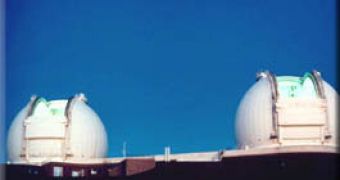Can a galaxy get bigger overnight? Not for real, but we may find out, and not overnight, that is bigger than we had thought.
At least that was the conclusion of a team of astronomers led by Scott Chapman, from the California Institute of Technology, and Rodrigo Ibata, from the Observatoire Astronomique de Strasbourg in France.
Their project was to map out the detailed motions of stars in the outskirts of the Andromeda galaxy.
Their recent observations with the Keck telescopes show that the tenuous sprinkle of stars extending outward from the galaxy are actually part of the main disk itself. This means that the spiral disk of stars in Andromeda is three times larger in diameter than previously estimated.
At the annual summer meeting of the American Astronomical Society today, Chapman will outline the evidence that there is a vast, extended stellar disk that makes the galaxy more than 220,000 light-years in diameter. Previously, astronomers looking at the visible evidence thought Andromeda was about 70,000 to 80,000 light-years across. Andromeda itself is about 2 million light-years from Earth.
The new dimensional measure is based on the motions of about 3,000 of the stars some distance from the disk that were once thought to be merely the "halo" of stars in the region and not part of the disk itself. By taking very careful measurements of the "radial velocities," the researchers were able to determine precisely how each star was moving in relation to the galaxy.
Chapman says that further work will be needed to determine whether the extended disk is merely a quirk of the Andromeda galaxy, or is perhaps typical of other galaxies.
The main paper with which today's AAS news conference is concerned will be published this year in The Astrophysical Journal with the title "On the Accretion Origin of a Vast Extended Stellar Disk Around the Andromeda Galaxy." In addition to Chapman and Ibata, the other authors are Annette Ferguson, University of Edinburgh; Geraint Lewis, University of Sydney; Mike Irwin, Cambridge University; and Nial Tanvir, University of Hertfordshire.
More details at http://www.astro.caltech.edu/~schapman/m31.html

 14 DAY TRIAL //
14 DAY TRIAL //